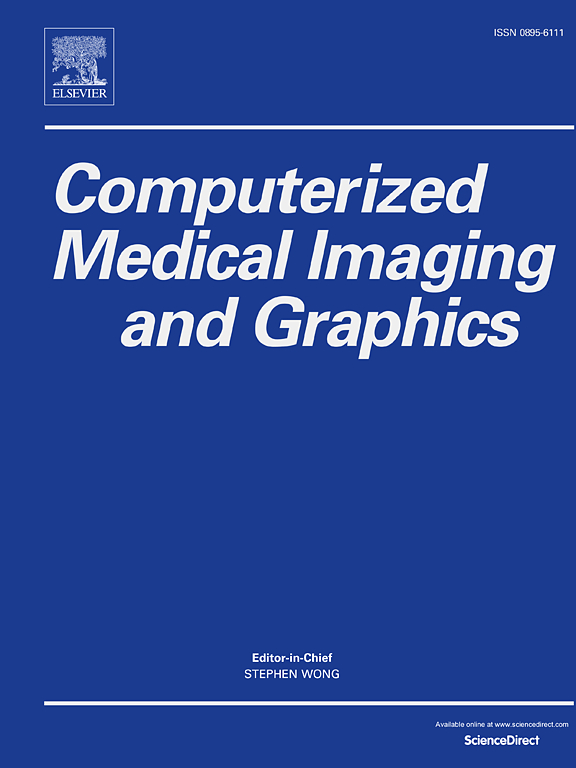Robust brain MRI image classification with SIBOW-SVM
IF 5.4
2区 医学
Q1 ENGINEERING, BIOMEDICAL
Computerized Medical Imaging and Graphics
Pub Date : 2024-10-24
DOI:10.1016/j.compmedimag.2024.102451
引用次数: 0
Abstract
Primary Central Nervous System tumors in the brain are among the most aggressive diseases affecting humans. Early detection and classification of brain tumor types, whether benign or malignant, glial or non-glial, is critical for cancer prevention and treatment, ultimately improving human life expectancy. Magnetic Resonance Imaging (MRI) is the most effective technique for brain tumor detection, generating comprehensive brain scans. However, human examination can be error-prone and inefficient due to the complexity, size, and location variability of brain tumors. Recently, automated classification techniques using machine learning methods, such as Convolutional Neural Networks (CNNs), have demonstrated significantly higher accuracy than manual screening. However, deep learning-based image classification methods, including CNNs, face challenges in estimating class probabilities without proper model calibration (Guo et al., 2017; Minderer et al., 2021). In this paper, we propose a novel brain tumor image classification method called SIBOW-SVM, which integrates the Bag-of-Features model with SIFT feature extraction and weighted Support Vector Machines. This new approach can effectively extract hidden image features, enabling differentiation of various tumor types, provide accurate label predictions, and estimate probabilities of images belonging to each class, offering high-confidence classification decisions. We have also developed scalable and parallelable algorithms to facilitate the practical implementation of SIBOW-SVM for massive image datasets. To benchmark our method, we apply SIBOW-SVM to a public dataset of brain tumor MRI images containing four classes: glioma, meningioma, pituitary, and normal. Our results demonstrate that the new method outperforms state-of-the-art techniques, including CNNs, in terms of uncertainty quantification, classification accuracy, computational efficiency, and data robustness.
利用 SIBOW-SVM 进行稳健的脑部 MRI 图像分类。
脑部原发性中枢神经系统肿瘤是影响人类最严重的疾病之一。无论是良性还是非良性、神经胶质还是非神经胶质的脑肿瘤,其早期检测和分类对于癌症的预防和治疗都至关重要,最终将提高人类的预期寿命。磁共振成像(MRI)是检测脑肿瘤最有效的技术,可生成全面的脑部扫描图像。然而,由于脑肿瘤的复杂性、大小和位置的可变性,人工检查容易出错且效率低下。最近,使用卷积神经网络(CNN)等机器学习方法的自动分类技术已证明其准确性明显高于人工筛查。然而,基于深度学习的图像分类方法,包括 CNN,在没有适当模型校准的情况下,在估计类概率方面面临挑战(Guo 等人,2017 年;Minderer 等人,2021 年)。在本文中,我们提出了一种名为 SIBOW-SVM 的新型脑肿瘤图像分类方法,它将特征袋模型与 SIFT 特征提取和加权支持向量机整合在一起。这种新方法能有效提取隐藏的图像特征,从而区分各种肿瘤类型,提供准确的标签预测,并估算图像属于每一类的概率,从而做出高置信度的分类决策。我们还开发了可扩展、可并行的算法,以促进 SIBOW-SVM 在海量图像数据集上的实际应用。为了对我们的方法进行基准测试,我们将 SIBOW-SVM 应用于脑肿瘤 MRI 图像的公共数据集,其中包含四个类别:胶质瘤、脑膜瘤、垂体瘤和正常。结果表明,新方法在不确定性量化、分类准确性、计算效率和数据鲁棒性方面都优于包括 CNN 在内的最先进技术。
本文章由计算机程序翻译,如有差异,请以英文原文为准。
求助全文
约1分钟内获得全文
求助全文
来源期刊
CiteScore
10.70
自引率
3.50%
发文量
71
审稿时长
26 days
期刊介绍:
The purpose of the journal Computerized Medical Imaging and Graphics is to act as a source for the exchange of research results concerning algorithmic advances, development, and application of digital imaging in disease detection, diagnosis, intervention, prevention, precision medicine, and population health. Included in the journal will be articles on novel computerized imaging or visualization techniques, including artificial intelligence and machine learning, augmented reality for surgical planning and guidance, big biomedical data visualization, computer-aided diagnosis, computerized-robotic surgery, image-guided therapy, imaging scanning and reconstruction, mobile and tele-imaging, radiomics, and imaging integration and modeling with other information relevant to digital health. The types of biomedical imaging include: magnetic resonance, computed tomography, ultrasound, nuclear medicine, X-ray, microwave, optical and multi-photon microscopy, video and sensory imaging, and the convergence of biomedical images with other non-imaging datasets.

 求助内容:
求助内容: 应助结果提醒方式:
应助结果提醒方式:


